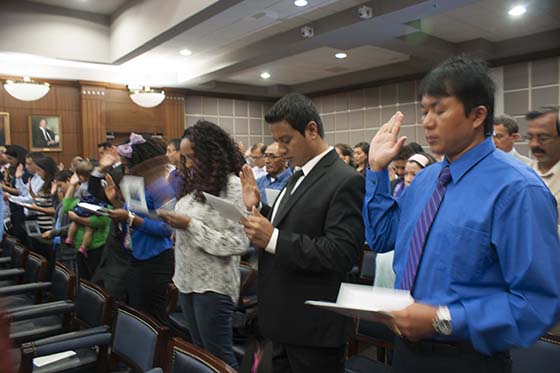What To Expect When You’re Expecting a Senate Immigration Reform Bill

Sen. Patrick Leahy (D-Vt.) opens debate after the Senate passes a motion to proceed.
The immigration reform bill making its way through the Senate passed two major hurdles today when the upper chamber voted to invoke cloture and then voted for a motion to proceed with debate. The two procedural votes are important as it was a procedural dust up that killed reform efforts in 2007.
Now that a motion to proceed has passed, Senators will begin debating the substance of the bill. They’ll also be able to offer amendments to the bill.
Keep up with the latest from UnidosUS
Sign up for the weekly UnidosUS Action Network newsletter delivered every Thursday.
Our friends over at the American Immigration Council put together a great blog post on what you can expect going forward.
From Immigration Impact:
What happens when there’s a motion to proceed?
When the Senate votes on a motion to proceed to consider, it means they’re voting to begin debate about the substance of the bill. It’s the way to bring a measure to the floor where there is not unanimous consent. For legislative business, it is debatable and may be subject to filibuster, which means there must be at least 60 votes to prevent a filibuster. Notably, Sen. John Cornyn (R-Texas) said he would vote in favor of the motion to proceed even though he was voting against the bill in committee. And Senate Minority Leader Mitch McConnell (R-Ky.) also has said he’d vote for the motion to proceed. “With regard to getting started on the bill, it’s my intention…to vote for the motion to proceed so we can get on the bill and see if it we’re able to pass a bill that actually moves the ball in the right direction,” he said on the last day of committee markup.
What comes after that?
This is the point during which senators can add amendments to the bill on the Senate floor. Debate on a measure is unlimited unless cloture is invoked, so senators can speak for as long as they like. And amendments do not have to relate directly to the bill. After the smooth markup process in the Senate Judiciary Committee, the floor fight over the immigration bill is expected to be more combative. It also could be more disjointed compared to the committee’s tight process, where amendments were posted online days in advance and the committee debated them mostly in order. In comparison, senators on the floor can call up any amendment once they have been recognized, whether it is related or not. Senators who are designated as floor managers will organize the process. And as during the committee markup, senators can offer second-degree amendments to the ones that their colleagues propose. They can also consider substitutes to the amendments, and in those situations, “senators can propose six or more first- and second-degree amendments to the substitute and the measure before any votes must occur,” according to the Senate process.
What amendments might come up?
The most contentious amendments will be the ones about border security requirements. Some senators do not agree that the Gang of Eight’s border provisions are strong enough, including Cornyn. He will propose the RESULTS amendment, which includes a laundry list of metrics—including a biometric entry-exit system and 100 percent monitoring of the southern border—that must be met before green cards could be offered to undocumented immigrants. Sen. Joe Manchin (D-W. Va.) has said he will offer an amendment to require undocumented immigrants who came to the U.S. as children to obtain a degree or serve in the military before they could be eligible for the expedited path to citizenship. And Senate Judiciary Committee members likely will raise amendments withdrawn during markup. For example, Sen. Richard Blumenthal (D-Conn.) said he is “seriously considering” bringing up a gun control amendment to the Senate bill that he withdrew during markup before the committee could vote on it.
What about the final vote?
To reach a vote on S. 744’s final passage, there will be a cloture vote, or a motion to close debate (although debate can continue for a set time afterwards) again requiring 60 votes. This is where the varying reports about whether or not there are 60 senators who will vote for the bill come in. Some say they have the votes, while others disagree. But more senators are saying they are in favor of the bill. Over the weekend, Sen. Kelly Ayotte (R-N.H.) announced her support for the Senate immigration bill. But the Senate vote is only part of the congressional process. Speaker John Boehner (R-Ohio) is pushing for the House to take up an immigration bill while the Senate works on theirs, and if the two chambers pass separate pieces of legislation, then it will go to a conference committee to hammer out the differences.

